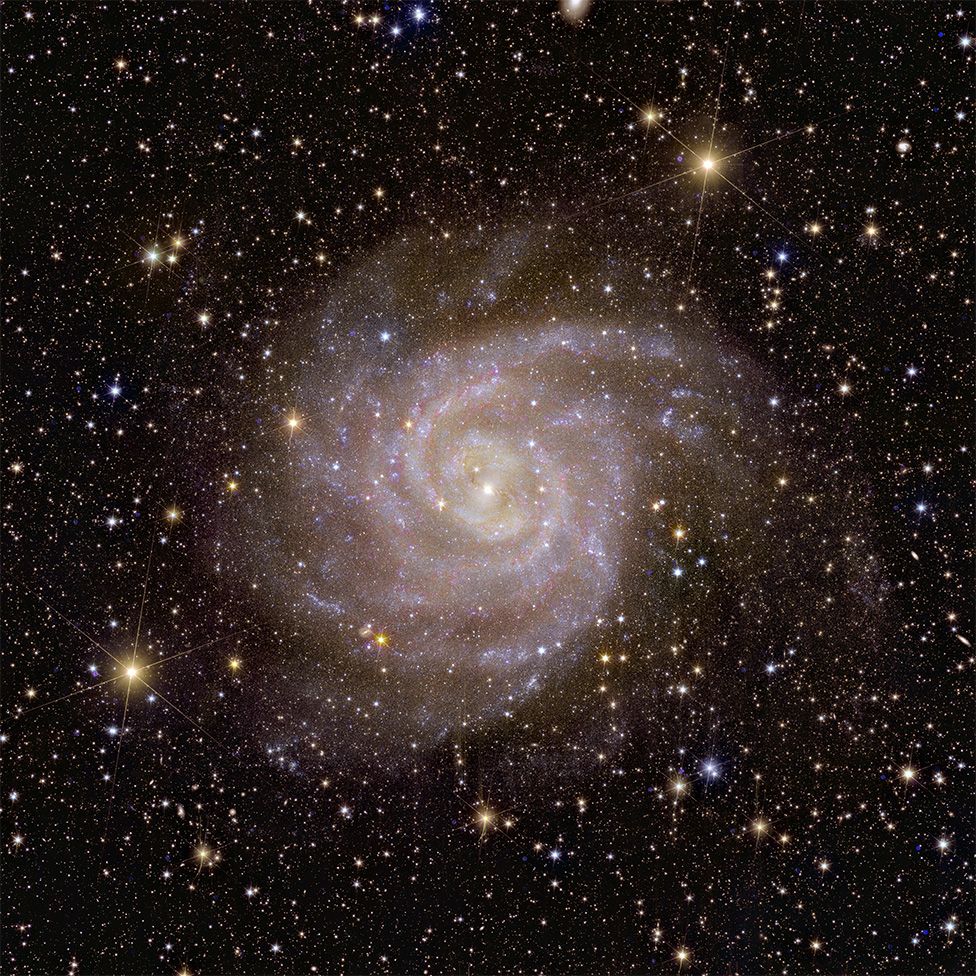10 minutes ago
About sharing
Europe’s Euclid telescope is ready to begin its quest to understand the greatest mysteries in the Universe.
Exquisite imagery from the space observatory shows its capabilities to be exceptional.
Over the next six years, Euclid will survey a third of the heavens to get some clues about the nature of so-called dark matter and dark energy.
These unknown “influencers” appear to control the shape and expansion of everything that’s out there.
Researchers concede, however, they know virtually nothing about them, even though they probably account for 95% of the contents of the cosmos.
Neither dark matter nor dark energy are directly detectable. Our only hope of gaining some understanding is to trace their subtle signals in the things we can see.
This will be Euclid’s job: to observe the contours, distances and motions of billions of galaxies, some of whose light has taken almost the entire age of the Universe to reach us.
Somewhere in the statistics of this 3D cosmic map – the largest ever made – scientists expect to find answers.
The Horsehead is a great cloud of gas and dust where stars are being born. It’s relatively close, just 1,300 light-years from Earth. Many telescopes have imaged this scene but none have done so with the combined width and sharpness that Euclid can achieve.
Euclid’s survey will be the most fundamental of inquires, argued Prof Carole Mundell, the director of science at the European Space Agency (Esa).
“We are human, we want to understand everything around us; whether that was as ancient people looking at the night sky and drawing constellations on our caves, or trying to understand whether the Sun would come back after the winter – we seek that knowledge and insight,” she told BBC News.
“We don’t currently understand 95% of the Universe, a universe that is 13.8 billion years old. We’re sentient beings who’ve been around for a tiny fraction of that time, but we could be the species that gets to figure it all out.”
Dark matter and dark energy are among the biggest puzzles in modern astrophysics.
The former could be some as-yet-undetected particle. Astronomers infer its presence from the gravitational pull it exerts on the matter we can see. Galaxies would fly apart if it wasn’t there.
The latter represents a very different problem. It could be some kind energy in the vacuum of space. Whatever it is, it appears to be working against gravity to push galaxies apart at an ever-accelerating rate.
Perseus Cluster
The Perseus Cluster is one of the most massive structures in the Universe. This image contains 1,000 galaxies from this group, but beyond are tens of thousands more galaxies, some of whose light has taken 10 billion years to reach us.
The €1.4bn (£1.2bn) Euclid telescope went into space in July. Since then, engineers have been fine-tuning it.
There were some early worries. Initially, Euclid’s optics couldn’t lock on to stars to take a steady image. This required new software for the telescope’s fine guidance sensor.
Engineers also found some stray light was polluting pictures when the observatory was pointed in a certain way. But with these issues all now resolved, Euclid is good to go – as evidenced by the release of five sample images on Tuesday.
“They are fantastic,” said Prof Isobel Hook, who worked on one the teams in the 1990s that first discovered the Universe was expanding at a faster and faster pace.
“I finally saw the images at full resolution on Monday, and they really blew me away. We were expecting Euclid to perform very well and it really has met all our expectations. It’s a big relief and really wonderful to see,” the Lancaster University astronomer enthused.
NGC 6397
Located a mere 7,800 light-years from Earth, NGC 6397 is what’s termed a globular cluster. It’s an ancient grouping of stars, some of which are almost as old as the Universe itself. They are cosmic fossils that tell us about the history of galaxies such as our own Milky Way.
No previous space telescope has been able to combine the breadth, depth and sharpness of vision that Euclid can.
The astonishing James Webb telescope, for example, has much higher resolution, but it can’t cover the amount of sky that Euclid does in one shot.
“This giant camera with billions of pixels is now ready to go and survey the distant Universe and objects over a vast range of the sky – a vast volume of the sky in space and in time,” said Prof Mark McCaughrean.
“It’s only by looking at huge numbers of galaxies that we’ll be able to tease out those subtle signals for dark energy and dark matter, which is what Euclid is all about,” Esa’s senior scientific advisor told BBC News.
NGC 6822
Evolved galaxies like our own Milky Way and IC 342 display beautiful spiral arms. But NGC 6822 is an example of an irregular galaxy. It doesn’t have that defined shape. Many galaxies in the early Universe look like NGC 6822, although it’s relatively close, just 1.6 million light-years from Earth.
Engineering challenge
No, this isn’t some bizarre galaxy discovered by Euclid. The telescope had a problem locking on to a “guide star” during early testing. Until engineers could upload new software to its fine guidance sensor, the observatory was swivelling all over the sky.
Artwork: Euclid has been given six years to assemble its 3D map of one-third of the sky. The telescope is special because it combines breadth, depth and sharpness of vision. It needs these qualities to be able to probe a large volume of the sky within a practical timeframe.
